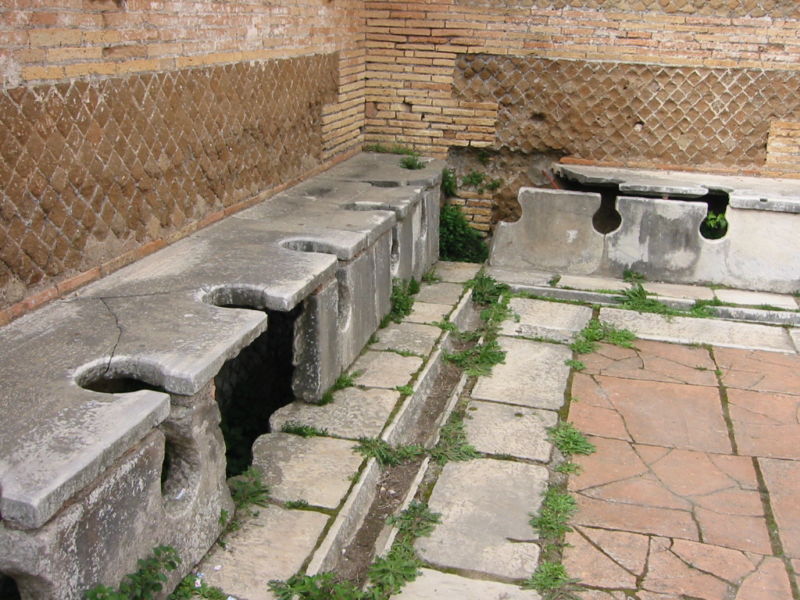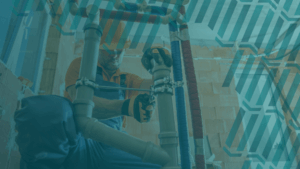The history of plumbing dates back to some of the earliest civilizations around the world – and looking at how the industry has evolved over time can help your current plumbing business figure out what its next best steps are.
Plumbing is arguably one of the most important trades across the maintenance industry, without it – the streets would be flooded and our homes would be underwater.
The Earth’s surface is 70% water and humans have built major past and present cities around having easy access to it.
To start, let’s look back to the first recorded instance of plumbing…

Early Civilization Plumbing History
Around 4000 BC the Mesopotamians or Ancient Greek civilizations were using sewage pipes made from clay to help collect rainwater and export wastewater. But that wasn’t the only region of the world with a need for plumbing. Around the same time, in the early days of India, those who settled along the Indus River were some of the first to use copper pipes for their plumbing needs.
Fast forward a bit to roughly 2500 BC and we see instances of Ancient Egyptians using similar copper piping systems to build bathrooms and transport water or waste in and out of pyramids. As people started to spread out across the globe around 1500 BC, plumbing for bathing and cooking was standard. It was near this time that toilets (known as water closets) were becoming available to have in homes.
Next, comes the Roman Empire and all its technological advancements. The exact years of their reign are argued, but it’s speculated that they lasted from roughly 500 BC to 600 AD. Throughout this time, the Romans were using lead or bronze to develop their plumbing and pipes. They were one of the first groups to focus on sanitation and sewage systems to provide “clean” water across the city. After the fall of the Roman Empire, safe plumbing practices and advancements came to a halt while the world continued into the early middle (or dark) ages.
It wasn’t until much later, nearly the 1500s, that metalworkers in Germany figured out how to smelt iron into plumbing pipes. Shortly after, toilets with flushing capabilities were created and pipelines that stretched across entire cities were established across Europe. But the issue once again was sanitation…
The State of New York came to the rescue when they created the first underground sewer system in the 1720s (due to complaints about the smell from residents). About 100 years later, they installed the first main waterline to help firefighters easily get the water they needed.
In the 19th century, more plumbing practices and standards were being introduced everywhere, leading to the National Public Health Act. Pipes with a specific number of fixtures for the transportation, drainage, storage, and sanitation of water were becoming standard and regulated.
Moving into the present day, it’d be tough to imagine life without the access to water that we currently have – and plumbers are the key cog in the water ignition. Making sure our appliances are functioning properly within the regulations set forth by the government.
The Evolution of the Plumbing Business
After looking at the history of plumbing, it’s easy to see why plumbers are such an important part of society. Everyone needs to use water for multiple purposes daily and plumbers are the ones that make it happen.
With the Eastern coast of the United States being the first place settlers landed, naturally we saw one of the first plumbing businesses, Diller Wierman Inc, come to life there. This family business was established in 1779 – 14 years after the original owner, Michael Barglet came to the US from Germany and found himself in McAllister’s town (present-day Hanover, Pennsylvania).
In its early years, the company operated in carpentry before transitioning into manufacturing copper stills for alcohol production. Over the next 150 or so years, the company was passed down between a handful of generations and expanded operations to include common plumbing services along with HVAC (and other custom metalworks).
This is just one of the plumbing companies across the nation out of the many thousands that exist and operate daily. As you know, plumbers are used in many different instances and their services are needed across multiple industries – creating the opportunity for sustainable and sometimes niche plumbing businesses. If you’re interested in learning about the career of a plumber – check out how you can become a plumber!
The way a plumbing business runs has changed drastically over time. Now that society has a dwindling number of skilled and knowledgeable maintenance or trade workers, their value is at an all-time high as plumbers are able to take on a wider variety of tasks or issues compared to the past.
Running a cost-efficient plumbing business has become the bottom line for most companies these days. Whether it’s minimizing transportation costs by optimizing routes, trying new marketing tactics, or utilizing new technologies introduced to the industry, there’s plenty you can do to get your business where you want it to be.
Any business, regardless of industry, that fails to adapt to changes will get left behind by the competition that is able to adjust. The old way of doing things just won’t cut it anymore if you want to make it – especially considering the current state of the economy.
But there is more than one answer to change – keep in mind that change and adaptation for your business will most likely not be the same as others. Sure, you can get insights from your peers in the industry – but what works for your business will be unique.
Plumbing Businesses Today: It’s all about the customer
Diller Wierman Inc couldn’t have imagined the kind of stiff competition modern plumbing businesses have to face. There are advantages to being a pioneer, that’s certain. In today’s world, the customer has become the king and it’s only getting hard to stand out.
Most are using technology and analytics to improve specific aspects of their company and individual departments. If your teams don’t have key performance indicators (KPIs) and metrics to work towards, you’ll quickly see issues throughout your operations.
These will show up as bad reviews in no time – and prospects listen to reviews above almost anything. Some maintenance KPIs you can use are: productivity, customer reviews, operational costs, etc.
Don’t stay stuck in the past…
When it comes to the maintenance industry and plumbing in general, there are many ways to think about how to set up your KPIs and put your customer first.
Using software, like Commusoft, will allow you to easily keep track of all the necessary details.
Creating a better experience for your customers, technicians, and management will help streamline your business from top to bottom.

Anthony Vattimo
Thanks for checking out the Commusoft blog - I’ve been helping business owners improve their strategies for a few years now, so I hope you were able to take something away from the content I’ve written. Feel free to continue exploring the blog - or reach out to us with any questions!










